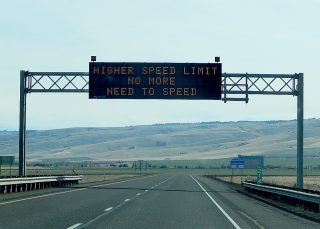
(Photo: ODOT)
The faster a vehicle travels, the more likely it is to hurt its operator or other road users. Advocates know this, first responders know this, traffic engineers know this, safety experts knows this. It’s a simple concept that fuels a lot of policy and advocacy — yet some politicians are still enthralled with the idea that the benefits of going faster outweigh the human costs.
After we got our first clue about two weeks ago, we’ve now confirmed that the Oregon Department of Transportation has commenced an engineering report on raising truck speeds on interstate highways. The move comes after an unnamed lawmaker said they plan to introduce legislation in the 2017 session to raise the speed limit on I-5 and two other major highways.
Let’s back up a bit…
In 2015 the Oregon Legislature passed a bill (HB 3402) that raised speed limits for car and truck drivers on some rural highways (up to 65 or 70 mph respectively). Legislators outside of urban areas pushed for the bill on grounds that higher speeds are necessary to make long drives more convenient and they don’t hurt anyone because rural areas are so sparsely populated.
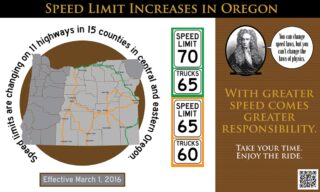
But at least one key ODOT safety expert disagreed and testified against the bill. In an interview back in June, ODOT Traffic Safety Division Manager Troy Costales told me he urged lawmakers to vote no. “My recommendation was that they not do that,” he said. “While you can engineer the road and the vehicle, you’re not engineering the human body to be able to sustain any more impact… In other states when speeds have gone up, fatalities and injuries have gone up. You can expect a 3-5 percent increase.”
Despite that expert advice, legislators pushed ahead and got the votes they needed. Oregon’s higher speed limits went into effect on parts of 11 rural interstates in central and eastern Oregon in March of 2016.
Then, just over two months later, Anita Bemrose and her three sons (ages 10, 12 and 14) were killed on one of the highway sections where speeds were raised. Bemrose was stopped and waiting to make a left turn off the highway when she was rear-ended. The impact pushed her and her sons into oncoming lanes where another person slammed into their car.
That tragedy spurred the Oregon Department of Transportation to lower the speed limit in that segment of highway along with three others. For the Bemrose family, it was too late.
Now I’ve learned of yet another attempt to increase speed limits on Oregon highways.
On November 21st, ODOT published a notice about an upcoming meeting of their Speed Zone Review Panel. One line in the announcement caught my eye: “Agenda items include a discussion about a proposed engineering report to investigate raising truck speeds on some interstates.”
With plenty of evidence that higher speeds lead to higher rates of injury and death, with ODOT’s recent passage of a Traffic Safety Action Plan that makes strong verbal commitments to achieving zero traffic deaths, and with the recent rollback of speeds following a quadruple-fatal crash, I was shocked to see what appeared to be another attempt to increase speeds.
On November 23rd I followed up with ODOT to learn more about the meeting and ask why ODOT was investigating higher truck speeds.
Advertisement
The first person who replied was ODOT Traffic Investigations Coordinator Kathi McConnell. She said she didn’t think there was any specific request to increase speeds and that ODOT was simply being proactive in this circumstance. McConnell referred to an established process the Speed Zone Review Panel follows (in accordance with Oregon Administrative Rule 734-020-0010, “Establishment of Speed Limits on Interstate Highways”) wherein ODOT puts together a report to research any requests to change speed limits.
The OAR makes it clear a report is only done if someone requests a change. So I followed up with ODOT again: If that report was being presented, wouldn’t that mean someone requested to increase speeds?
ODOT seemed reluctant to admit that a speed increase was on the table.
“Again, my understanding is that no one outside of ODOT requested a particular increase in speed limits anywhere, but that we are being proactive in preparing by taking these first steps in case anyone, including the upcoming legislature, requests a review.”
— Shelley Snow, ODOT public affairs
In an emailed reply, ODOT Strategic Communications Coordinator Shelley Snow wrote, “What she [McConnell] meant was an [ODOT] administrator requested the report, not an increase! The report is the first step in the whole process and my understanding is that it is about being prepared in case there is a request down the line.”
I was still not satisfied with that answer, so I asked again: Why would the panel discuss raising truck speeds and why would an engineering report be started if no one had requested higher speeds? Does ODOT staff have so much time on their hands that they can afford to create reports on issues no one is really asking about?
This time Snow repeated her understanding that no one had requested a speed increase and that the person who could answer my question, State Traffic Engineer Douglas Bish, was unfortunately out of the office. “Again, my understanding is that no one outside of ODOT requested a particular increase in speed limits anywhere,” Snow wrote, “but that we are being proactive in preparing by taking these first steps in case anyone, including the upcoming legislature, requests a review.”
It still didn’t add up to me so I waited to hear from Bish. He emailed on December 2nd.
“The Highway Division Administrator (Paul Mather) asked our Section to start the study. He was notified by a legislator of an intention to introduce legislation to raise interstate truck speeds.”
— Doug Bish, ODOT Traffic Engineer
Turns out there was a request for a speed limit increase. A legislator (Bish said he doesn’t know who) has asked ODOT to look into increasing speed limits for car and truck drivers on three new sections of interstates: Most of I-5 south of Portland, a small part of I-205 and I-84 from Troutdale to The Dalles (the 2015 bill increased speeds on I-84 east of The Dalles). As part of this request Bish said ODOT plans to update a 2004 report (PDF) that took a comprehensive look at interstate speed limits.
Bish added that ODOT Highway Division Administrator Paul Mather asked the traffic engineering section to start the study. Mather was notified by a legislator who intends to propose legislation to raise truck speeds. “If the process supports the raise in truck speeds, ODOT could move forward without legislation,” Bish wrote, “If study did not support raising truck speeds or if the legislator still wants to move forward, ODOT would be better prepared to have discussions.”
As part of the update of that interstate speed report, ODOT will convene public meetings around the state in areas where the speed limits might be changed. The process should be completed by September 2017.
I realize this doesn’t directly impact cycling in Portland; but it does impact cycling in rural areas where highways are often the only place to ride. And the larger context matters. Does our state DOT prioritize safety over speed? Should we allow our safety and transportation policy to be decided by legislators who are more concerned with votes in their district than the well-being of all road users? Is ODOT able to openly communicate transportation policy to the public in a meaningful and transparent way that allows us and them to make informed opinions about life and death issues? Should a state that’s committed to zero traffic fatalities even consider raising speed limits?
Stay tuned.
— Jonathan Maus, (503) 706-8804 – jonathan@bikeportland.org
BikePortland is supported by the community (that means you!). Please become a subscriber or make a donation today.



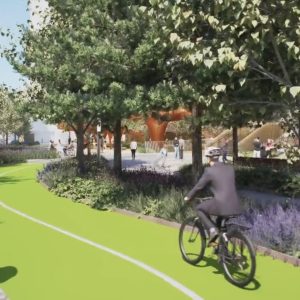
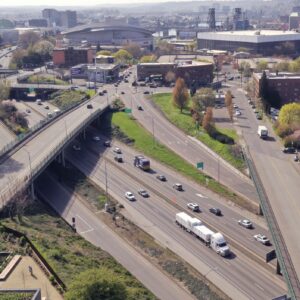
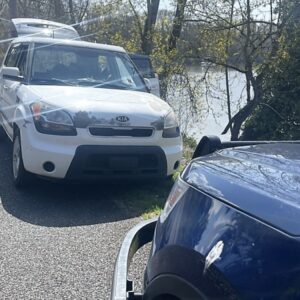
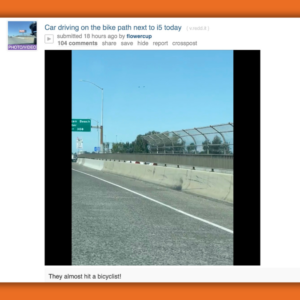
Thanks for reading.
BikePortland has served this community with independent community journalism since 2005. We rely on subscriptions from readers like you to survive. Your financial support is vital in keeping this valuable resource alive and well.
Please subscribe today to strengthen and expand our work.
Jonathan, I have to disagree with your statement: “I realize this doesn’t directly impact bicycling…” but speeding trucks do “impact” the safety of bicyclists sharing the shoulders of rural highways…unless ODoT creates effective and convenient alternative routes like it has in the Gorge.
I hope ODoT understands this does undermine the suitability for long distance bike touring along some routes and thus its efforts at marketing bike touring tourism as an economic model for some rural areas.
As Newton would remind the engineers (I just loved the use of him on the ODoT slide)
…faster speeds = less reaction time (& even less for seeing cyclists motorcyclists) = greater mass if striking an object…
PS. Jonathan…thank you for reporting on this and what it takes to bring it some daylight before it is a done deal (such as reading boring subcommittee agendas…contacting folks deep in the bureaucracies etc.)
yeah. thanks Todd. Meant to add something about that. I am not 100% sure bicycles are even allowed on the specific highways in question, but I added a few words about it to the story just in case.
ODOT allows bikes on 217.
PAGE 19 of the Oregon Bicyclist Manual, revised in 2010, lists the locations where bikes are not allowed.
Cool. T
The devil is in the details. Increasing limits on interstates could actually be good for bicycle touring by increasing incentives for trucks to take interstates rather than rural two lane highways. As one of the very few cyclists willing to ride on interstates, I would say the wind blast and safety issues from speeding trucks on interstates are much less than on other highways.
Oregon is pretty liberal about allowing bicycles on interstates, and the few places where it’s illegal are truly dangerous. What makes them dangerous is not the speed of the traffic as much as what you have to cross. Try riding I-5 across the 205 interchange when things are moving full blast. Totally legal, but dangerous. Regular entrances and exits are much easier to deal with since you can ride partially up exits to avoid being caught by surprise and you can always see vehicles on the on ramps.
What they definitely don’t need to do is to increase the speed limits on roads that aren’t limited access (i.e. any road you can simply pull onto from a road or stop on without an acceleration/deceleration ramp)
“…Increasing limits on interstates could actually be good for bicycle touring by increasing incentives for trucks to take interstates rather than rural two lane highways. …” banerjee
Bearing in mind that I personally, rarely have to travel them by motor vehicle (never by bike), I’m kind of resigned to the fact of pressure to allow posted speeds higher than 65 and 70 on major, multiple lanes in both directions, such as on I-5, I-84, I-205. Not that I feel those speeds are a great idea, or even necessarily beneficial overall.
If it’s happening that these higher speeds are being also allowed on two lane roads throughout the state falling within the very general definition of ‘highway’, I greatly object to that. Even lacking deaths or injuries arising from collisions directly associated with the higher speeds, I think that environmentally, the impact of such high motor vehicle speeds on the countryside they pass through is awful. Particularly as it relates to tourism and recreational use of such roads.
Oregon is a state of beautiful, grand vistas outside the urban centers along the I-5 corridor, yet many of us residents unwittingly allow that resource to be diminished by the desire by some interests and individuals for ever higher speeds on roads throughout the state….
While greater speed is usually more dangerous, that is not always the case. However, in the case at hand, I would want to see some actual data supporting the idea that letting trucks go faster is at least as safe as what we have before changing the law.
The laws of physics dictate that trucks simply can’t be stopped or handled as effectively as much smaller vehicles and the damage they do when they hit something is far greater. However, speed differentials also cause problems and there is the additional factor that if trucks are moving at the same speed as everyone else, others are less likely to get frustrated and engage in unsafe behavior.
I personally like having the big vehicles over to the right moving more slowly and predictably, so I’m happier if things stay as they are. But if they’re serious about considering the issue, they should look at real data produced by independent researchers.
Not specific to trucks, but germane to the discussion of raising speed limits on I-5 south of Portland. A decade ago, the tiny city of Coburg began raising revenue by issuing speeding tickets on I-5 just north of Eugene. Not surprisingly, there was a lot of local anger over this. Coburg reached out to a former police official from Springfield to analyze the data. This former official, whose name I can’t recall, was a vocal opponent of Coburg’s actions.
After he conducted his analysis, he completely changed his outlook. He found that the enforcement of the speed limit by Coburg had created the safest stretch of I-5 in the state. Of course the legislature took steps to make such enforcements by small cities illegal, so it no longer takes place.
Fast forward to yesterday when fourteen cars smashed into each other on that part of I-5, closing it for hours. Needless to say, speed was a factor in this latest pile up.
I remember that Coburg complaint, too. According to newspaper accounts at the time, they were only issuing citations for motorists exceeding 85 mph! People from Eugene and Springfield had persuaded their legislators that it was a ‘speed trap.’ Is there anyone who actually believes that 85 is an appropriate speed in a 65 mph zone?
85 mph is only a safe speed for someone who is a highly skilled driver driving a well tuned car without distractions. That pretty much rules out 99% of the users of the interstates in this country.
“Is there anyone who actually believes that 85 is an appropriate speed in a 65 mph zone?”
tons of people! I used to drive that fast…
This makes a great case in favor of speed traps. Americans have a strange , romantic hallucination about a “right” to drive. The words “driving” and “automobile” appear exactly zero times in the US Constitution and Bill of Rights.
A number of factors could be at play. First of all, that is the straightest and flattest section of I-5 — you can literally take your hands off the wheel. It is not near any major source of traffic gnarliness (Eugene hardly qualifies and the effect is gone by Coburg). And if people expect enforcement, they may actually pay attention when driving which I personally believe is the single most important component in safety. So that stretch should be relatively safe.
There is no doubt that high speeds are problematic when people zone out. I personally think I-5 between Portland and Eugene is too busy to justify high speeds. Cars drive too close to each other at speeds they couldn’t possibly stop at and the results are situations like that pileup you reference.
But it is a fallacy to think that people drive slower just because lower speeds are posted. It is also a fallacy to think that they’ll always speed by about the same amount.
Getting safety dialed in is all about getting the physical and human factors optimized. What actually works the best is unlikely to be what people would like to work best.
I much prefer the trucks to be going a different speed. It is no fun having a truck tailgating you as you go 70 mph down the highway. I hate driving where the truck speed limit is the same as the car speed. It’s hard to stay away from the trucks. I don’t want to be anywhere near those things for many reasons.
There is no need to be near anyone. If someone catches you from behind, they are faster than you — let them through. If you catch them, you are faster — overtake them.
One traffic dynamic I constantly observe is that vehicles travel in tight “knots” where everyone jockeys for position within a tight formation. If one catches you from behind, the last thing you want to do is join it.
Rather, lift off the gas so they get by you quickly and you can resume a more sane driving experience. Likewise, if you catch a knot, you need to decide if you’re willing/able to dump the entire group. If you can, great. If not, your best bet again is to fall off the back. It’s not like you’ll get to your destination any quicker by tailing 100 yards behind the insanity.
If you’re in heavy traffic where you can’t pull ahead and dropping behind only gets you cut off, then get behind someone who can’t stop as fast as you can and follow as far back as you can without getting cut off.
I attended ODOT’s Transportation Safety Conference in October. One of the presentations covered the increased rural highway speeds mandated by the legislators. It’s pretty obvious that rural legislators will be asking again and again for increased speeds if they don’t get a response they like, the asking will be changed to a demand.
If the study was started because someone at ODOT asked for it, I think it is safe to say that it was only in an attempt to be ahead of the request from rural legislators.
I’ve got some issues with ODOT, but you have to see where the pressure comes from. The trucking association and other rural interests are constantly in contact with legislators and are well organized. If we’re going to be successful in pushing a safety agenda, or whatever, we have to use the same model.
If the pressure from legislators is building to the “inevitable” speed increase…then perhaps the “best” thing to do would be to support it with some horse trading:
-lower night time speeds (dynamic speed limits based on time and weather),
– investment in bike facilities / safety measures in these areas,
– rural transit investment,
– hard shoulder upgrades (widening bridges at pinch points), etc.
you’re already supposed to drive slower at night…
It would be helpful to be able to look into the future a bit and find out which innocent people are going to die as a result of speed increases, so we can get their opinion on it.
I’d bet dollars to doughnuts that this legislator would describe himself as “pro life”.
Thanks Eric, that is what my response was going to be, except on the other side of the coin. Everyone is so upset about loosing a life on the interstate, yet the thousands of lives who are lost by people making a “choice” every year in our country continue to go unnoticed. 🙁
people have life concerns on both side of the issue.
Sad face emoji
All that danger just to get across the whole state 20 minutes faster?
As a former truck driver, it is my opinion that there is no stretch of I-5 south of Portland that should have a truck speed limit in excess of 55 mph. With very few exceptions, the terrain is either hilly, curvy and/or foggy.
As it is, we have far too little law enforcement on I-5. I remember when one would see a trooper, on average, about every forty or fifty miles. These days, one can go thousands of miles without seeing a single member of law enforcement and people drive like they know that.
Perhaps our legislature should consider transferring some of ODOT’s budget to the state troopers instead of making sure ODOT has enough spare time to look at unnecessary and dangerous speed limit increases.
I5 also crosses many creeks and rivers.
I’d agree with all that. Leave speeds as they are.
Make it 55 again. Where are the new, planned multi-use paths along so many ODOT highways? 217 desperately needs one.
The whole I-5 corridor needs a ped/bike route along it.
I’m OK with the speeds like they are today. 70 is fast enough on rural freeways for cars. Same with 65 for trucks. At least in Oregon trucks are supposed to go 5 mph slower – that helps. It is not fun when a truck passes you and takes 2 miles to do it because he’s barely going faster. Also when roads are wet, it is dangerous if a truck is going just below the car speed limit and you want to pass so you can drive the speed limit, and the truck is putting up a wall of spray that you can’t see thru to pass safely. At least if he’s going slower you can get past him quicker.
.
Would not raise speeds on 2 lane rural roads. Keep them as they are.
Speeds should absolutely NOT be increased from Troutdale to The Dalles. The highway is fairly windy, lots of trees near the road that can hide deer, and deer regularly cross that road. Also, at night when it’s wet you cannot see anything. The east and westbound lanes are close together and the concrete barrier is too low to block headlights of oncoming traffic. That section of highway is dangerous even with the current speed limits.
No changes to the speed limits. One change I would allow: no speed limit for motorcycles on rural sections of I-84, between The Dalles and Pendleton, that are straight with unlimited visibility and only when the sun is at your back and you can go fast without passing other cars at a speed greater than 15 mph over the limit (gotta slow down when passing). Zoom! 🙂
Winding (curvy), not windy. Although the wind can be a hazard in the gorge. 🙂
Can’t tell if you are joking…
It’s no big deal. Let er’ rip.
Nope, not joking. Let the motorcycles have a legal spot to open ‘er up. If they did hit a car, probably would not kill anyone but themselves. There would need to be limitations on temperatures, times for each week of the year (like a tide table), perhaps wind restrictions, maybe only allowed when indicated by signs, etc.
ODOT sure can move on getting a report to increase highway speeds that apparently nobody has asked for yet…but just look at how long it took (and is still taking) for them to review Barbur Blvd.
I think this just says to me that ODOT will do whatever it wants, and will come up with any number of excuses or roadblocks when it comes to things they don’t want to do.
That’s quite a message on the sign: “Higher speed limit—No more need to speed”. Was there a need to speed before?
Thought that was funny too. If there is no need to speed… why was the speed limit raised?
Ask the legislators who pushed HB3402 through last session.
ODoT is so laughably stupid it makes my head hurt. Who is clamoring for this speed limit change? Lemmee guess… the freight “community”
This change would mean almost zero in terms of productivity but ends up creating more injury and significantly worse MPG. Actually, when you think about it, a semi truck accident is a serious affair and often results in road closures and delay, therefore, even a couple of delays would wipe out any upside to the economics of increased speeds.
Do the math: Driving the entire length of Oregon on I-5 @ 60 MPH takes 5.1 hrs, driving @65 MPH takes 4.7 hrs. a grand total of 22min for all that white knuckling.
Bear in mind no one is proposing any segment nearly this long be sped up, the net result is not faster delivery of goods and lower labor to shippers (or higher per-mile pay for those paid under that rubric) it is simply more wasted gas, greater pollution and more serious accidents.
And with the positives being so minuscule as to be nearly incalculable, one should even weigh the hard costs to the state for funding such changes: the hours of expert study and cost of implementing such changes. Those freeway signs are not free, neither is the labor.
yes
A 5 mile per hour increase, from 60mph to 65mph, in top speed for trucks on major highways and freeways, isn’t much of an increase. Is there any solid indication at all, in the form of first hand experience or studies conducted, indicating that the 5mph higher difference, results in an increase of collisions involving trucks? Maybe there such and indication, somewhere…but in the absence of some proof, I’m inclined to think any increase is likely negligible.
What conceivably could happen though, is that somehow, people of this state, and ODOT staff, could be gradually persuaded, through trial period of the 5mph increase from 60mph to 65mph with negligible increases in collisions…that progressively higher speeds could be allowed, possibly also with negligible increases in collisions. Do your math for 70, 75, 80, 85 mph. The 22 minute border to border trip time savings could be increased to 60 minutes or more. Time is money. And the pres elect would love it.
Yes, since ODOT began raising the speed limits we’ve had so much less death on our roadways, haven’t we? Oh, we’ve seen an increase that’s greater than the increase in miles driven? Oh well, must be something else.
I don’t have access to the data, not that it should be necessary to prove, but a company I drove for had two flavors of truck: 90% of them were governed at 62 mph and the remainder were ungoverned. All drivers alternated between two trucks with no more than one of them being ungoverned. It should come as no surprise that there was no significant productivity difference but there was a significant difference in crash numbers. Eventually, the company governed all trucks in order to keep their costs down.
Granted, 62 mph was higher than the truck speed limit at the time which was 55 mph. The only slower trucks on the road were the UPS trucks. It would be interesting to see some comparison in terms of crash rates for UPS and other haulers of double/triple combinations. I’d bet dollars to doughnuts that the UPS interstate fleet has a lower crash rate.
Trucks need to have a different speed than cars so cars can get away from them. They are unsafe. They can’t stop fast, they spray huge amounts of water when it’s wet, they have a trail of grit and rocks behind them, they weave around in the wind, etc. Stay far away from trucks.
It seems ODoT needs to get out of Marion County a little more. Not everyone wants to fly around in their lifted F350s yet they are hell bent on representing the rural faction to the detriment of the vastly more populous urban areas. Sort of reminds me of how the media bends over backwards and summersaults to cover ridiculous viewpoints of climate change deniers just to make it appear that it is representing all sides.
Good Grief. Most other states have the same speed and it’s fine. This just makes BP look like a left wing loon site. It’s annoying to drive around Portland with Rolling roadblocks.
Mr Smith,
Slower traffic is safer. Fact.
Kinetic energy is a function of speed squared and mass.
This is why managing speed is important.
Random facts with no connection to reality. No thanks.
The strongest argument favoring high motor vehicle speeds, on, let me say, freeways and major multiple lane highways, is cost effectiveness of trip time reduction. Start doing the numbers though, which many people would rather not…and then see if the reduced trip time at 75mph or even up to 95mph, compared to 55 or 60, really is worth all the negative consequences that go along with the higher speeds.
Higher speeds require greater energy consumption…greater demands on skill and ability of people driving (one aspect of this is that at higher speeds, greater numbers of people driving, young and old, will be hard pressed to meet those demands.). Environmental and livability impacts resulting from noise and pollution arising from motor vehicles traveling at high speeds.
A couple reasons not even having anything to do with cost effectiveness, that some people favor high motor vehicle speeds, I would imagine, is that they may find driving at higher speeds to be personally more exciting. Also…some people likely want to drive faster simply because that means they spend less time on the road if their trip time is shorter. The law of diminishing returns comes into play.
It is true that time savings are much less than people imagine and that there are noise, pollution, etc aspects. But just as there are diminishing returns when going faster, there will also be some when going slower.
If people are going so slow that they are substantially less engaged, they could easily be less safe rather than more safe. Likewise, slowing traffic down too much will bunch up vehicles which is bad on many levels and the speed differentials with scofflaws will be much higher. None of that is good for safety.
What makes things safe depends on many factors, but I do believe there is such a thing as a generally prudent speed and that less than that is not a good thing.
Note that I am not in any way advocating for higher limits. My general sense is that they are too high in some places and I wish tickets would be issued more frequently for driving too fast for conditions (i.e. people driving speed limits for dry pavement and good visibility in conditions where that’s obviously unsafe)
No, BP is a loonily rational website. Once you get outside of the alt-trans and environmental communities, mainstream American ideas about transportation are both stupid and insane.
It is annoying to risk one’s life just to walk or ride a bike on many roads and ODOT-maintained urban bleakways in the Portland area.
Lay a sacrifice upon the altar of speed!
How many more do we have to sacrifice to this particularly blood-thirsty god? I’m tired of seeing the absolutely crushed loved ones describe their losses.
“it’s fine”
We’re on track to reach about 40,000 road deaths in the US this year, which surpasses gun deaths and is on-par with drug overdoses. Speed is a contributing factor in a majority of fatal crashes. Is this your definition of fine?
no, it’s not fine… people are dying… we’d like the state to rein that in but they want to do the opposite…
it’s not fine…
Daylight is best. All such requests should be in writing by ODOT policy, or legislation. Anonymous requests only shield cowards.
The freight lobby also needs to be discredited.
Several years ago I was traveling in a charter bus on the autobahn in Germany and asked the driver why she never moved out of the right lane which was limited to about 55mph. She replied, ” it is verboten for buses or trucks to ever leave the right lane, and if they do their commercial license will be revoked.”
Sounds like a good policy to me.
Guess the driver was messing with you. Buses can go 100kph (62 mph); trucks are limited to 80 kph (50mph). Both are allowed to pass, unless otherwise posted. https://de.wikipedia.org/wiki/Bildtafel_der_Verkehrszeichen_in_der_Bundesrepublik_Deutschland_von_1992_bis_2013#/media/File:Zeichen_277.svg
But her company may impose additional restrictions, which is exactly what many US trucking/bus companies do. Many trucks on the interstate here have fleet-standard speed regulators, so drivers can’t speed (liability, fuel consumption, etc).
While those things help enforce good general practice, they have their problems too.
For example they cause congestion and needlessly tight driving when passing someone who is going just slightly under the limit.
Many trucks are limited to 55mph.
I’ve never seen one regulated at 55. The slowest on the road that I’ve seen are UPS at about 57-59. Wal-Mart are often just above that. Do you know of a specific company that regulates their rigs at 55?
Of course, this entire discussion is academic, given the ‘lax’ enforcement of speed limits in Oregon. I drive on the east side of the mountains, 97 or 395. Trucks go essentially the same speed as cars, when they can (not hilly or curvy), which is about 75 in 65 mph zones. The odds of getting a speeding ticket in Central and Eastern Oregon is close to zero, except in and around population centers. OSP staffing has gone down dramatically, as our population has increased, and it will only get worse with State’s budget woes.
I smell the long arm of Amazon seeking to speed Prime deliveries until they get the drone fleet online.
And then we will have to watch out for “incoming” at all angles in three dimensions (other than from below, I hope) instead of just all angles in two dimensions as we do now.
ODOT being proactive for convenience but not for safety speaks volumes about their true priorities.
Do truckers fall asleep? Yes. Do truckers talk on cell phones? Yes. Do truckers drop lit cigarrettes on their lap? Yes. Do truckers drive 80,000 pounds of steel and often volatile cargo? Yes. But let’s go FASTER. Twenty minutes is well….twenty minutes!
People already go 65-80 MPH on I-205 so I do not see the need to raise the speed limit. I usually go about 72-73 in a 65 zone and 76-78 in a 70 since I usually do not feel like going faster. I do not even know if my Caravan would want to go 80-85 for long stretches.
Exactly right.
The trucking industry is not looking at the saved time costs of one trip. Keep that in mind. Multiply it by round trip per year per truck, multiply that by truck fleet, multiply that by all trucks over a year. You start to talk real money then…a lot of it. I’m not advocating for it but I am suggesting we know what we’re arguing about.
Calc the increased fuel consumption versus the labor cost. Which is higher?
Paid by the mile, or hourly?
This is what we’re arguing about:
https://www.google.com/search?q=18+wheeler+wrecks&biw=1195&bih=590&source=lnms&tbm=isch&sa=X&ved=0ahUKEwjU84HexuPQAhVP0GMKHehaBZEQ_AUIBygC
I hope it passes.
Not me. Speeds are good in Orygun. If you want to go faster go to Idahole or Utah or Nevada or some place………..
Jonathan,
I always see this site arguing against higher speed limits. Can you instead do an article on the RIGHT speed limits? Let’s say for freeways like I-5 or I-84 outside cities. Crash rates and reaction time put an upper bound on what a speed limit should be. What defines the lower bound? Everything I’ve seen on this site suggests the lower bound is zero; that everything gets better the slower you go, without limit. I don’t think that’s actually true. There must be some factors that argue for a faster limit, and some that argue for lower. At what speed do these two meet? Where is that RIGHT limit? That’s an article I’d like to see.
my take:
urban areas: 20-25 mph.
rural roads: 25-40 mph (depending on traffic counts, geography, and cross traffic)
on limited access roads: 55 mph (or lower as conditions require).
More truck tire shreds along highway shoulders. Wrong choice.